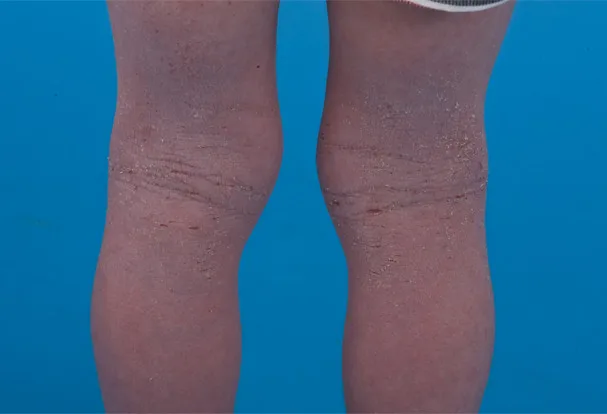Have you ever been puzzled by the redness on your legs, wondering if it’s a passing discomfort or a potential sign of a more serious condition? Redness on legs can be perplexing, and the distinction between common occurrences and medical concerns like cellulitis is crucial. In this article, we unravel the mystery surrounding redness on the legs, providing clarity on differentiating between benign red legs and more serious cellulitis.
Let’s embark on a concise journey through symptoms, causes, diagnosis, and treatment options, ensuring you have the essential insights to navigate the complexities of leg-related concerns. Don’t let the redness go unnoticed; read on to empower yourself with knowledge and understanding.
Differentiating Between Red Legs and Cellulitis
Have you ever found yourself questioning the nature of the redness on your legs? Is it just a temporary irritation or something more ominous, like cellulitis? Let’s clear up the confusion and delve into distinguishing between common red legs and potentially more serious cellulitis.
Have you got cellulitis or redness on legs?
Visual Cues:
To differentiate between red legs and cellulitis, pay attention to visual cues. Red legs from irritation or mild inflammation often present as a diffuse redness, sometimes accompanied by itching. On the other hand, cellulitis may exhibit a more localized and intense redness, often with distinct borders.
Physical Sensations:
Consider the physical sensations associated with the redness. Red legs due to irritation might cause mild discomfort or itching. In cellulitis, the redness is typically accompanied by heat, swelling, and tenderness, signaling an underlying infection.
Duration and Persistence:
Temporary redness that resolves quickly might be more indicative of common red legs. However, if the redness persists, especially with worsening symptoms, it raises concern for cellulitis, warranting prompt attention.
Systemic Symptoms:
While red legs might be a standalone issue, cellulitis is often accompanied by systemic symptoms like fever. If you feel unwell and experience an elevated body temperature along with red legs, it’s essential to consider the possibility of cellulitis.
Conclusion:
In differentiating between red legs and cellulitis, a keen observation of visual cues, consideration of physical sensations, awareness of duration, and attention to systemic symptoms play crucial roles. Understanding these distinctions empowers you to make informed decisions regarding your leg health. In the next sections, we’ll explore cellulitis in detail, ensuring you have a comprehensive understanding of this potentially serious condition. So, let’s move forward and unravel the intricacies of cellulitis and redness on the legs.
Hot, Swollen And Tender
The affected area may exhibit intense redness that extends beyond the initial site of infection. The heat emanates from the inflammation, and the swelling and tenderness are indicative of the body’s immune response.
Overview: hot, Swollen, Tender Red Legs
Visualizing Cellulitis:
To recognize cellulitis, envision a localized area on your legs where the skin is not only red but also notably warmer to the touch. The redness tends to spread, creating a distinct demarcation between affected and unaffected areas.
What does cellulitis look like?
Distinct Borders:
Unlike some mild skin irritations that might have a diffuse redness, cellulitis often presents with well-defined borders. This clear distinction between infected and healthy tissue is a key visual cue for identifying cellulitis.
Possible Blistering:
In severe cases, cellulitis might lead to the formation of blisters filled with fluid. This is an advanced stage and warrants immediate medical attention.
Conclusion:
Understanding cellulitis involves recognizing its visual and physical characteristics. The combination of hot, swollen, and tender red legs, along with distinct borders and potential blistering, sets cellulitis apart from common redness. In the subsequent sections, we’ll explore the symptoms, causes, diagnosis, and treatment of cellulitis, providing you with the insights needed to navigate this skin condition effectively. Let’s move forward and unravel the complexities of cellulitis and its impact on leg health.
Symptoms of Cellulitis
Recognizing the Signs
The cardinal symptoms of cellulitis are hot, swollen, and tender skin. If you notice a sudden increase in temperature in a specific area of your leg, accompanied by pronounced swelling and tenderness, it could be indicative of cellulitis.
Redness Beyond the Norm:
While redness is a common symptom, the redness associated with cellulitis goes beyond a mild irritation. It often presents as a deep, intense red color that spreads from the initial site of infection. This redness can be a helpful visual cue for identifying cellulitis.
Identifying Common Symptoms
Skin Tenderness:
Gentle pressure on the affected area may reveal heightened skin tenderness. If you notice increased sensitivity when touching the red and swollen part of your leg, it’s a clear indication of the inflammatory response associated with cellulitis.
Progression of Symptoms:
Cellulitis symptoms can progress rapidly if left untreated. What may start as a small area of redness can escalate to widespread inflammation and potential blistering. Monitoring the progression of symptoms is essential for seeking timely medical intervention.
Conclusion:
Recognizing the symptoms of cellulitis involves paying attention to both visual and sensory cues. From the characteristic hot, swollen, and tender skin to the presence of systemic symptoms like fever, understanding these signs empowers you to take proactive steps in addressing cellulitis. In the next sections, we’ll explore the potential causes of cellulitis, diagnostic procedures, and available treatment options. Let’s continue our journey through cellulitis awareness, ensuring you know how to navigate this skin condition effectively.
Causes of Cellulitis
Cellulitis, a bacterial skin infection affecting the deeper layers, often stems from specific causes. Understanding what can trigger cellulitis is crucial for both prevention and effective treatment. Let’s explore the potential causes that pave the way for this inflammatory condition.
Exploring Potential Triggers
Invasive Procedures:
Surgical procedures, injections, or even tattooing that breach the skin’s barrier pose a risk of introducing bacteria. Proper post-procedural care is essential to prevent infection, including the development of cellulitis.
Addressing Underlying Issues
Prompt wound care:
Timely and proper care of wounds, no matter how small, is crucial in preventing cellulitis. Cleaning, disinfecting, and applying suitable dressings can minimize the risk of bacterial entry.
Managing skin conditions:
Individuals with pre-existing skin conditions should diligently manage their skin health. Regular moisturizing, avoiding irritants, and seeking prompt treatment for flare-ups can reduce the susceptibility to cellulitis.
Compression Therapy:
For individuals with peripheral edema, compression therapy can be beneficial. This may involve wearing compression stockings or sleeves to reduce swelling and minimize the risk of cellulitis.
Conclusion:
Understanding the causes of cellulitis is essential for preventing its occurrence and managing the condition effectively. From addressing breaks in the skin to managing underlying health issues, taking proactive steps plays a key role in reducing the risk of cellulitis. In the next sections, we’ll explore the diagnostic process for cellulitis and the available treatment options. Let’s continue our exploration, ensuring you know how to navigate the complexities of cellulitis and redness on the legs.

Diagnosis of Cellulitis or Redness on legs
Navigating the diagnostic process for cellulitis involves a careful examination by healthcare professionals. From visual assessments to discussions about symptoms and potential risk factors, understanding how cellulitis is diagnosed is pivotal for timely and effective management.
Navigating the Diagnostic Process
Visual Examination:
The diagnostic journey often begins with a visual examination. Healthcare professionals will inspect the affected area for signs of cellulitis, including redness, swelling, and tenderness. The distinct borders and localized heat are key visual cues.
Discussion of Symptoms:
Your healthcare provider will engage in a discussion about your symptoms. Describing the nature, duration, and progression of redness, along with any associated pain or systemic symptoms like fever, provides crucial information for diagnosis.
Medical History Review:
A review of your medical history is essential. Any pre-existing skin conditions, recent injuries, or underlying health issues that may compromise your immune system will be considered. This information helps in assessing the risk factors for cellulitis.
Risk Factor Assessment:
Given that certain conditions and behaviors increase the risk of cellulitis, your healthcare provider may assess specific risk factors. This includes evaluating the presence of peripheral edema, chronic skin conditions, or a history of recent invasive procedures.
What to Expect at Your Appointment
Physical Examination:
During the appointment, your healthcare provider will conduct a thorough physical examination. This involves not only assessing the affected leg but also checking nearby lymph nodes to gauge the extent of the infection.
Imaging Studies:
In some cases, imaging studies, such as ultrasounds, may be recommended. These studies can help visualize deeper tissues and assess the extent of the infection.
Conclusion:
The collaboration between you and your healthcare provider is crucial for an accurate diagnosis. In the upcoming sections, we’ll delve into the available treatment options for cellulitis, ensuring you’re equipped with the knowledge to address this bacterial skin infection effectively. Let’s continue our exploration of cellulitis and redness in the legs.
Treatment Options for Cellulitis
Addressing cellulitis head-on involves a multifaceted approach to eliminate the bacterial infection and alleviate symptoms. From antibiotic therapy to managing pain and adopting self-care practices, understanding the available treatment options is crucial to a comprehensive approach to cellulitis.
Addressing the Issue Head-On
Antibiotic Therapy:
The cornerstone of cellulitis treatment is antibiotic therapy. Prescribed antibiotics target the bacterial infection causing cellulitis. It’s essential to complete the full course of antibiotics as prescribed, even if symptoms improve before the medication is finished.
Self-Care Tips:
In addition to prescribed medications, adopting self-care practices can aid in the healing process. Elevating the affected leg, applying warm compresses, and getting plenty of rest can contribute to symptom relief.
Skin Care:
Taking care of the affected skin is crucial for preventing complications and promoting healing. Keeping the area clean and moisturized, as well as avoiding irritants, supports the skin’s recovery.
Antibiotic Therapy
Follow-Up Care:
Regular follow-up appointments with your healthcare provider are essential during and after the antibiotic course. These appointments allow for an ongoing assessment of your response to treatment and adjustments, if needed.
Prevention Strategies for Redness on legs
Preventing the recurrence of cellulitis involves a proactive approach, focusing on skincare, risk reduction, and therapeutic interventions. By adopting preventive measures, individuals can minimize the likelihood of experiencing redness in the legs due to cellulitis.
Proactive Measures
Prioritizing Skin Care:
Maintaining healthy skin is paramount in preventing cellulitis. Regular washing with mild soap, moisturizing to prevent dryness, and promptly addressing any cuts, wounds, or insect bites contribute to skin health.
Prompt wound care:
Immediately attending to any cuts, wounds, or insect bites is crucial. Thoroughly cleaning the affected area, applying antiseptic if necessary, and covering the wound with a clean dressing to prevent bacterial entry.
Avoiding Irritants:
Identifying and avoiding potential irritants is essential. Harsh soaps, chemicals, or allergens can compromise the skin’s integrity, making it more susceptible to infections.
Conclusion of redness on legs Post
In conclusion, understanding and managing redness on legs requires a nuanced approach that encompasses careful observation, timely intervention, and proactive care. From recognizing the symptoms and causes to navigating the diagnostic process and treatment options, this comprehensive guide empowers individuals to prioritize their skin health. Knowing when to seek medical help is paramount, especially when faced with persistent redness, systemic symptoms, or severe discomfort. By embracing self-care practices, adopting preventive measures, and staying informed about various skin conditions, individuals can actively contribute to their overall well-being.



One thought on “Redness on legs: 13 Best Treat, Symptoms, Causes”